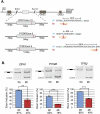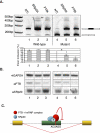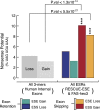Loss of exon identity is a common mechanism of human inherited disease
- PMID: 21750108
- PMCID: PMC3202274
- DOI: 10.1101/gr.118638.110
Loss of exon identity is a common mechanism of human inherited disease
Abstract
It is widely accepted that at least 10% of all mutations causing human inherited disease disrupt splice-site consensus sequences. In contrast to splice-site mutations, the role of auxiliary cis-acting elements such as exonic splicing enhancers (ESE) and exonic splicing silencers (ESS) in human inherited disease is still poorly understood. Here we use a top-down approach to determine rates of loss or gain of known human exonic splicing regulatory (ESR) sequences associated with either disease-causing mutations or putatively neutral single nucleotide polymorphisms (SNPs). We observe significant enrichment toward loss of ESEs and gain of ESSs among inherited disease-causing variants relative to neutral polymorphisms, indicating that exon skipping may play a prominent role in aberrant gene regulation. Both computational and biochemical approaches underscore the relevance of exonic splicing enhancer loss and silencer gain in inherited disease. Additionally, we provide direct evidence that both SRp20 (SRSF3) and possibly PTB (PTBP1) are involved in the function of a splicing silencer that is created de novo by a total of 83 different inherited disease mutations in 67 different disease genes. Taken together, we find that ~25% (7154/27,681) of known mis-sense and nonsense disease-causing mutations alter functional splicing signals within exons, suggesting a much more widespread role for aberrant mRNA processing in causing human inherited disease than has hitherto been appreciated.
Figures





Similar articles
-
MutPred Splice: machine learning-based prediction of exonic variants that disrupt splicing.Genome Biol. 2014 Jan 13;15(1):R19. doi: 10.1186/gb-2014-15-1-r19. Genome Biol. 2014. PMID: 24451234 Free PMC article.
-
Splicing defects caused by exonic mutations in PKD1 as a new mechanism of pathogenesis in autosomal dominant polycystic kidney disease.RNA Biol. 2015;12(4):369-74. doi: 10.1080/15476286.2015.1014291. RNA Biol. 2015. PMID: 25757501 Free PMC article.
-
Determinants of the Usage of Splice-Associated cis-Motifs Predict the Distribution of Human Pathogenic SNPs.Mol Biol Evol. 2016 Feb;33(2):518-29. doi: 10.1093/molbev/msv251. Epub 2015 Nov 5. Mol Biol Evol. 2016. PMID: 26545919 Free PMC article.
-
Regulation of alternative RNA splicing by exon definition and exon sequences in viral and mammalian gene expression.J Biomed Sci. 2004 May-Jun;11(3):278-94. doi: 10.1007/BF02254432. J Biomed Sci. 2004. PMID: 15067211 Free PMC article. Review.
-
Splicing mutations in human genetic disorders: examples, detection, and confirmation.J Appl Genet. 2018 Aug;59(3):253-268. doi: 10.1007/s13353-018-0444-7. Epub 2018 Apr 21. J Appl Genet. 2018. PMID: 29680930 Free PMC article. Review.
Cited by
-
IGF2BP3 Modulates the Interaction of Invasion-Associated Transcripts with RISC.Cell Rep. 2016 May 31;15(9):1876-83. doi: 10.1016/j.celrep.2016.04.083. Epub 2016 May 19. Cell Rep. 2016. PMID: 27210763 Free PMC article.
-
In silico tools for splicing defect prediction: a survey from the viewpoint of end users.Genet Med. 2014 Jul;16(7):497-503. doi: 10.1038/gim.2013.176. Epub 2013 Nov 21. Genet Med. 2014. PMID: 24263461 Free PMC article. Review.
-
A Compensatory U1snRNA Partially Rescues FAH Splicing and Protein Expression in a Splicing-Defective Mouse Model of Tyrosinemia Type I.Int J Mol Sci. 2020 Mar 20;21(6):2136. doi: 10.3390/ijms21062136. Int J Mol Sci. 2020. PMID: 32244944 Free PMC article.
-
Exonic Splicing Mutations Are More Prevalent than Currently Estimated and Can Be Predicted by Using In Silico Tools.PLoS Genet. 2016 Jan 13;12(1):e1005756. doi: 10.1371/journal.pgen.1005756. eCollection 2016 Jan. PLoS Genet. 2016. PMID: 26761715 Free PMC article.
-
OpenASO: RNA Rescue - designing splice-modulating antisense oligonucleotides through community science.bioRxiv [Preprint]. 2024 Oct 16:2024.10.15.618608. doi: 10.1101/2024.10.15.618608. bioRxiv. 2024. Update in: RNA. 2025 Jul 16;31(8):1091-1102. doi: 10.1261/rna.080288.124. PMID: 39463988 Free PMC article. Updated. Preprint.
References
-
- Barash Y, Calarco JA, Gao W, Pan Q, Wang X, Shai O, Blencowe BJ, Frey BJ 2010. Deciphering the splicing code. Nature 465: 53–59 - PubMed
-
- Benjamini Y, Hochberg Y 1995. Controlling the false discovery rate: A practical and powerful approach to multiple testing. J R Stat Soc Ser B Methodol 57: 289–300
-
- Biasiotto G, Camaschella C, Forni GL, Polotti A, Zecchina G, Arosio P 2008. New TFR2 mutations in young Italian patients with hemochromatosis. Haematologica 93: 309–310 - PubMed
-
- Boffelli D, McAuliffe J, Ovcharenko D, Lewis KD, Ovcharenko I, Pachter L, Rubin EM 2003. Phylogenetic shadowing of primate sequences to find functional regions of the human genome. Science 299: 1391–1394 - PubMed
-
- Bruno C, Tamburino L, Kawashima N, Andreu AL, Shanske S, Hadjigeorgiou GM, Kawashima A, DiMauro S 1999. A nonsense mutation in the myophosphorylase gene in a Japanese family with McArdle's disease. Neuromuscul Disord 9: 34–37 - PubMed
Publication types
MeSH terms
Substances
Grants and funding
LinkOut - more resources
Full Text Sources
Other Literature Sources
Medical
Miscellaneous
